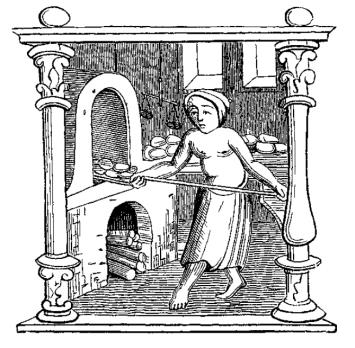

|
 A kind of bread or bun made of very fine flour, particularly that prepared for the Spring Festival. Commonly referred to as being boiled before being baked, in the manner of modern-day bagel bread. The precursor of the modern Simnel Cake The name may derive from the Roman 'simila conspersa', meaning 'fine flour'. The Cake is extremely old, known in England at least since the 13th Century (OED), and even turns up in the 1535 'Coverdale Bible' where Ezekiel. xvi. 19 has; "Thou didest eate nothinge but symnels, honny & oyle."  Bread-making, from a 16thC Book of Hours References from the 17th Century onwards show that Simnels were boiled before being baked, though the precise receipt is lost. For instance, A Willet's 'Hexapla in Exodum' of 1608 has; "Cakes tempered with oyle in the frying pan, and wafers boyled in water..like unto our simnels." The 'Copsley annals preserved in proverbs', by Emily Elizabeth Steele Elliott, 1867 has this poem; 'She who would a simnel make, There is a much-repeated joke story that 'Simnel' began with the cake-making activities of 'Simon and Nelly' - see Devizes Simnel Cake for the oldest known version. For reasons which are not clear, Simnel became associated with the Spring Festival in general, be it Mothering Sunday, Easter or the Mid-Lent day-off from fasting known as 'Refreshment Sunday', and the name became translated to a number of types of rich Springtime celebration cakes, usually involving marzipan, including: Devizes Simnel Cake Gloucester Simnel Cake Shrewsbury Simnel Cake ... though they have all largely been supplanted by the Bury Simnel Cake The novelist Elizabeth Cleghorn Gaskell, (1810-1865), writing of the traditions of Cheshire [Thanks to Bill Pearson and Diane Duffy] ('The Letters of Mrs Gaskell', 1997,Letter 12, pp. 28-33) says that "Then on Mid-Lent Sunday, instead of furmenty we eat Simnel cake: a cake made variously, but always with saffron for its principal ingredient. This I should fancy was a relic of Papistry, but I wonder how it originated. Lambert Simnel the impostor in Henry VIII's time was a baker's son, I think. the shop windows are full of them, high and low eat them". There is a tradition throughout Scandinavia and the Baltic of eating a springtime bun filled with marzipan called a 'semlor' in Sweden. There is a book of 1932 by ‘C. P. Smith’called "The feast of Mothering: how to make simnel cakes and other delights."  |
|
MORE FROM Foods of England... Cookbooks ● Diary ● Index ● Magic Menu ● Random ● Really English? ● Timeline ● Donate ● English Service ● Food Map of England ● Lost Foods ● Accompaniments ● Biscuits ● Breads ● Cakes and Scones ● Cheeses ● Classic Meals ● Curry Dishes ● Dairy ● Drinks ● Egg Dishes ● Fish ● Fruit ● Fruits & Vegetables ● Game & Offal ● Meat & Meat Dishes ● Pastries and Pies ● Pot Meals ● Poultry ● Preserves & Jams ● Puddings & Sweets ● Sauces and Spicery ● Sausages ● Scones ● Soups ● Sweets and Toffee ● About ... ● Bookshop ● Email: editor@foodsofengland.co.uk COPYRIGHT and ALL RIGHTS RESERVED: © Glyn Hughes 2022 BUILT WITH WHIMBERRY |